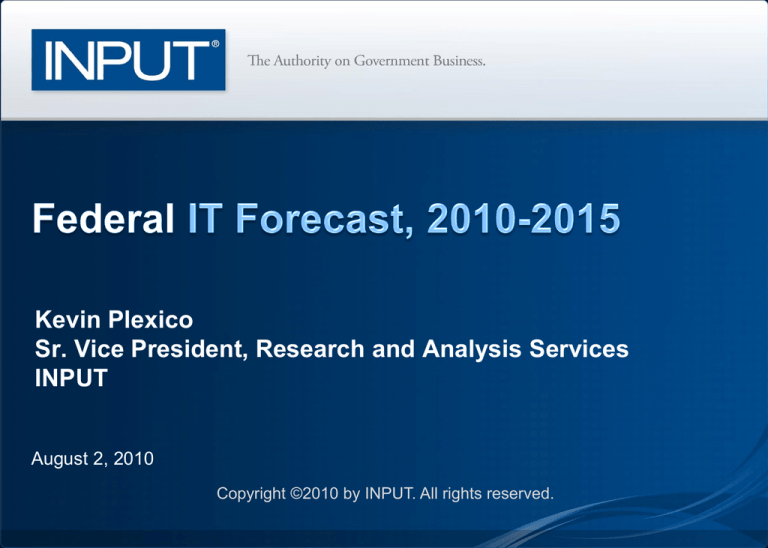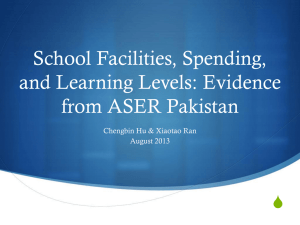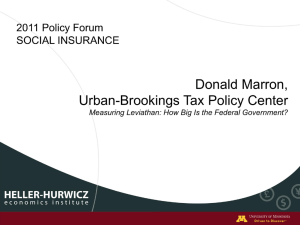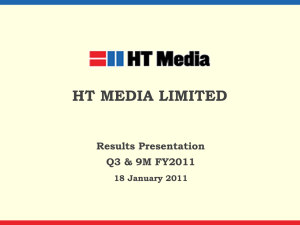
Kevin Plexico
Sr. Vice President, Research and Analysis Services
INPUT
August 2, 2010
Copyright ©2010 by INPUT. All rights reserved.
Agenda
Scope and Methodology
Trends and Drivers
•
•
•
•
•
Budget Environment
Performance and Accountability
Human Capital
Technology Priorities
Acquisition Trends
Technology Forecast
Conclusions and Recommendations
Copyright © by INPUT. All rights reserved.
2
Scope and Methodology
Scope
Methodology
U.S. federal information
technology (IT) spending FY2011
budget request
• Includes
INPUT bases its analyses,
segmentation, forecast, and
conclusions on:
•
President’s FY2011 budget request and
supporting documentation
Legislative and Judicial
branch
•
FY2011 OMB A-11 circular and Exhibit 53
Information Technology budget artifacts
Intelligence Community
•
Government-owned
corporations
Individual Departmental FY2011 budget
plans
•
Historical data on federal spending on
programs and technology
Embedded computer systems
•
IT grants to state
governments from HHS and
USDA
Economic forecasts for GDP &
discretionary spending
•
Analysis of agency plans and INPUT
Opportunities Database
•
Interviews with agency officials and
industry experts
Executive branch
• Excludes
Copyright © by INPUT. All rights reserved.
3
INPUT Survey Methodology
Survey Methodology
• One-on-one telephone interviews with
industry and government technology
professionals
• Web-based surveys targeting
industry and government technology
professionals
• Respondents assured that all
responses to be reported in aggregate
Copyright © by INPUT. All rights reserved.
4
Trends and Drivers
Copyright © by INPUT. All rights reserved.
5
Federal Outlays as a Percentage of GDP
45%
World War
II
CBO Estimates
40%
35%
30%
25%
Vietnam
War
Korean
War
20%
15%
Defense
Build-Up
10%
5%
0%
Outlays as Percentage of GDP
Outlays as Percentage of GDP (incl. HC reform)
Source: CBO; Bureau of Economic Analysis; INPUT
Copyright © by INPUT. All rights reserved.
Budget/Policy
6
Technology Budget Request
FY2011 President's Budget Request ($B)
$40
Total IT Budget Request: $79.4B
Overall Percent Change: -1.6%
+3%
$35
$30
$25
$20
$15
$10
-2%
-63%
+7%
-5%
$5
+33%
+25.4%
$0
FY2010 Enacted
FY2011 Request
Source: FY2011 OMB’s Report on Information Technology (Exhibit 53)
Copyright © by INPUT. All rights reserved.
Budget/Policy
7
Obama Policy Priorities and Impact on
Technology
• Modernize the
nation’s electric grid
• Reduce energy
consumption
• Utilize electronic
health records to
reduce costs
• Expand health care to
uninsured
Energy/
Conservation
Broadband
Healthcare
Cybersecurity
• Expansion of cyber
operations
• Consolidation of networks
to improve cybersecurity
• Expand broadband to
underserved and rural
areas
Copyright © by INPUT. All rights reserved.
8
Health IT Funding Ecosystem
Copyright © by INPUT. All rights reserved.
9
Cloud Computing
FEDRAMP
Centralized security
certifications service
SAJACC
Use case validation
of cloud offerings as
an interim “standard”
Copyright © by INPUT. All rights reserved.
BUDGET
REQUIREMENTS
Cloud computing
alternatives analysis
within the budget
process
Technology
10
Data Center Consolidation
Local Area
Networks
Virtual Private
Networks
Wide Area
Networks
Operations & Management
Data Center Network
(Not Included in
Analysis)
Data Center IT Software Assets
Middleware
» Database Servers
» Web Servers
» Application Servers
» Message Queues
» Directory Services
» Other Middleware
Applications,
Platforms, Services
VMs
Data Center IT
Facilities and
Energy
Data Center IT
Geographic
Location & Real
Estate
HVAC /
Cooling and
Energy
Consumption
Building
Leases,
Available
Floor Space
Power
Management
& Distribution
Geographic
Location of
Data Centers
Data Center Hardware Assets
Physical Storage / Network Storage
Special Purpose Hardware
Physical Servers / Mainframes
Switches, Routers, Firewalls
Power Source
& Alternative
Power
Supplies
High Speed Local Networks
Racks, Shelving and Cable Plant
Copyright © by INPUT. All rights reserved.
Technology
11
Federal Spending Continues to Outpace Available
Workforce to Manage and Implement
Source: OPM, OMB, INPUT
Human Capital
Copyright © by INPUT. All rights reserved.
12
Major Acquisition Reform Goals
Save $40 billion in contract spending • Reduce contractor spending by 7% (3.5% in
2010 and in 2011) by identifying wasteful,
inefficient, or ineffective programs.
Increase contracting transparency
• Reduce the combined use of ”high-risk
contracts,” e.g. no-bid contracts and costbased contracts, on new contract actions by
10% (over FY08 baseline).
Insource “inherently governmental”
work
• Clarify “inherently governmental” and
consider in-sourcing.
Increase the acquisition workforce
• Grow the acquisition workforce by 5% and
increase expertise.
Centralize IT acquisitions
• Centralization of key IT services
• Federal eMall for smaller purchases
Copyright © by INPUT. All rights reserved.
Acquisitions
13
Spending on Task Order-based Contracts
Source: FPDS, INPUT
Copyright © by INPUT. All rights reserved.
14
Recent Developments
Cut 5% of FY12 discretionary budgets
Freeze on financial system modernization projects
with $20M+ in planned spending
IT project reviews
Assessment of IT procurement and management
practices
Copyright © by INPUT. All rights reserved.
15
Technology Forecast
Copyright © by INPUT. All rights reserved.
16
IT Budget Requests vs. Actual
Only once since 1994 has
actual IT spending been
less than a president’s IT
budget request.
Source: OMB, INPUT
FY10 figures are OMB estimates.
*Enacted
**Assumes 103% of FY11 request.
Copyright © by INPUT. All rights reserved.
17
Addressable IT Forecast by Buying Segment
Source: OMB, INPUT
18
Copyright © by INPUT. All rights reserved.
Market Segment Forecast
Source: INPUT
19
Copyright © by INPUT. All rights reserved.
Conclusions and
Recommendations
Copyright © by INPUT. All rights reserved.
20
INPUT’s Take
There is still reason to be optimistic. Although overall government spending
may contract, IT has some level of immunity for a number of reasons:
•
•
•
•
Historical spending trends
Initiatives and objectives dependent on IT
Slow pace of insourcing; IT expertise is a major gap for government
Other low-hanging fruit for spending cuts (e.g. weapons systems, manual
processes, non-IT professional services, physical security, etc.)
“Near-term” technology priorities revolve around:
• Leveraging shared services (e.g. cloud computing, data center consolidation, geospatial
technologies);
• Automating processes to improve delivery of citizen services;
• Advancing information security: move to real-time security, improved ID management,
cyber incident sharing; and
• Investing in technology infrastructure to reduce costs and energy consumption
Security requirements will become much more robust (e.g., legislation,
Cyberscope, FedRamp, etc.)
• Congress still appears hesitant to put “teeth” into security compliance (e.g. cyber
coordinator budget control, security plan approval, etc.)
Copyright © by INPUT. All rights reserved.
21
Recommendations
Track agencies’ tech refresh cycles; likely target for investments to
support cloud computing, virtualization, green electronics, etc.
Pay close attention to Congressional activity:
• Be aware of the technology and policy implications of the numerous bills coming out of
Congress
• Election year will likely mean not much major budget cutting will occur until after
elections
Keep an eye on agencies with significant changes to
or expansion of mission for opportunities:
• VA – Projected expans
• IRS and HHS – health care reform (kicking in at the tail end of the forecast period)
Anticipate future compliance requirements as a requirement to do
business with government, such as: security of operations, carbon
footprint, financial records related to government-funded projects
Copyright © by INPUT. All rights reserved.
22
Q&A
Copyright © by INPUT. All rights reserved.
23












